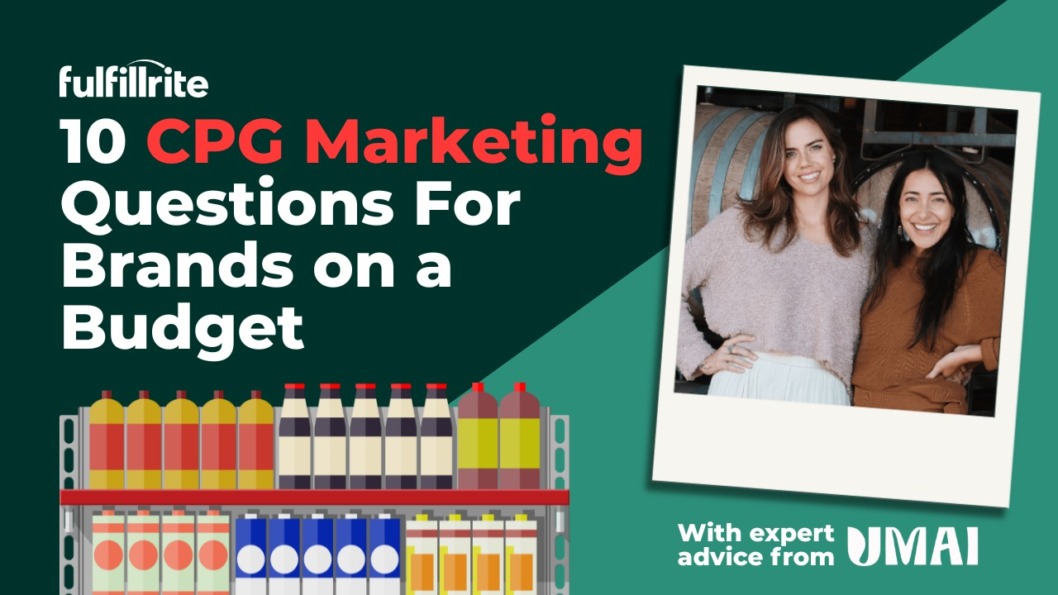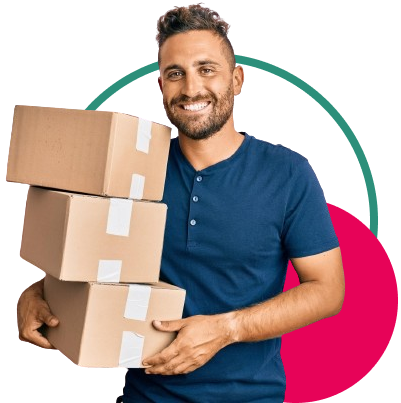10 CPG Marketing Questions For Brands on a Budget
Most consumer packaged goods (CPG) brands aren’t rolling in venture capital. And that’s okay.
You don’t need a million-dollar ad budget to succeed. But you do need focus. Clear strategy. The willingness to test things fast helps, as does a little grit.
To help you understand what CPG marketing looks like on a shoestring budget, we’ve brought in Alison Smith and Karin Samelson. They are the Cofounders of UMAI Marketing and have worked with dozens of CPG brands. They know what it takes to grow, without breaking the bank.
I sent them a bunch of questions by email, and they were kind enough to provide thorough responses. You can find their expertly written thoughts below, cited extensively throughout the post.
1. What’s the biggest challenge CPG brands face when trying to stand out?
“Money is number one, then time,” say Alison Smith and Karin Samelson, co-founders of UMAI Marketing.
It’s not that you can’t grow without outside funding. But it’s harder. Much harder.
“If a CPG brand doesn’t have the funds to hire help to sell and market their brand,” they explain, “then they are going to need to invest their own time to do so.”
There’s no shortcut around it. Either you’re hiring experts or doing the work yourself. And that means wearing every hat in the business—founder, marketer, operations, finance, customer service, and more.
“It’s not impossible to grow a successful brand without raising capital,” they add, “but it’s going to take a founder who is willing and has the time to wear all the hats.”
That’s the tradeoff. Cash or time. If you don’t have one, you need a whole lot of the other.
2. How has digital marketing changed how CPG brands sell their products?
A lot has changed in just the last few years. Long gone are the days when you needed a slick commercial and a big ad spend to make an impact.
“Less traditional advertising with overly thought-out (and EXPENSIVE) ad campaigns,” the co-founders say, “and more of a focus on of-the-moment, user-generated content that’s social first.”
That’s good news for smaller brands. You don’t need a creative agency or a big media buy. You need a phone, a little time, and a willingness to try things.
“CPG brands need to be nimble,” they explain. “Willing to test content. Not be afraid to have pieces of content fail. And have a human element to their marketing.”
This isn’t about getting it perfect. It’s about getting it out there.
When something resonates, double down. When it flops, move on quickly.
Being small gives you an edge here. Big brands have layers of approvals and brand guidelines to get through. You don’t. That means you can move fast, ride trends, and talk like a real person—because you are one.
Want to start simple? Share a founder video. Show your product in action. Repost customer content, ask questions, and answer comments. Or put another way: keep it real.
It doesn’t have to be polished. It just has to be you.
3. What’s the best way for CPG brands to drive sales in retail stores?
Digital and physical sales are more connected than most people think. If you want your product to move off the shelf, you have to do more than just get into the store—you have to drive people there and make sure the staff knows what they’re selling.
“Geo-targeted social ads with retailer coupons are one of the best ways to get people into stores and actually buy your product,” the co-founders say.
They recommend platforms like Aisle, which help brands offer digital coupons tied to specific retail locations. When a customer redeems the coupon, you get proof of purchase. That’s real ROI.
But don’t stop there.
“In addition to running ads,” they add, “have a good relationship with your buyer, schedule store demos, and educate store staff on your product.”
That last part often gets missed. If a store employee doesn’t understand what makes your product special, they’re not going to push it. But when they do understand? You’ve got an ally in the aisle.
“You have to build support both outside and inside the store,” they say. “That’s how you drive sales.”
4. How much does brand storytelling really matter for CPG marketing?
“A lot,” the co-founders say. “Especially if you don’t have million-dollar budgets.”
You can have the best product in the world, but if people don’t know your story—or worse, don’t feel anything about it—you’re just another jar on the shelf.
“If you don’t build that know, like, trust with your audience,” they explain, “then you’ll never achieve quality growth.”
This isn’t just about having a good origin story. It’s about giving people a reason to care. A reason to buy from you instead of the bigger, cheaper, or more familiar brand next to you.
“Give people a reason to support and rally behind you,” they say. “Even if you already have an awesome product. That reason is usually your story.”
And that story doesn’t have to be flashy. It just has to be real.
Did you start this company because of a personal need? Are you obsessed with your ingredients? Is your family involved? Are you fighting to stay independent?
Tell that story.
5. Does influencer marketing actually work for CPG brands?
Short answer: yes. But only if you do it right.
“Well, Poppi just got acquired for almost $2B,” say Alison and Karin. “So I think that answers your question!”
Poppi’s success with influencer marketing is impressive. But the co-founders make it clear—you don’t need VC money to make this strategy work.
“If you’re tight on cash,” they say, “find partners who really believe in your brand story + product, and may be willing to promote it for commission only (to start).”
That’s the key. Don’t chase big-name creators. Focus on real fans with loyal, engaged audiences.
And avoid the one-off $10K video trap.
“Stay far (far) away from influencers who immediately come to the table with ‘It will cost $10K for 1 video,’” they warn. “It’s absolutely outrageous what some of these content creators are charging.”
Even if you could afford it, it’s rarely a smart bet.
“Content quantity is important in this day and age,” they explain. “The odds aren’t in your favor for success with ONE video.”
Instead, think long-term.
“Negotiate a longer-term partnership to show their audience that they’re a true fan,” they say, “and not just peddling a new weekly product that doesn’t stick.”
That kind of repeat exposure builds trust—and trust leads to sales.
6. How can CPG brands use customer data to make better marketing decisions?
Good news: you probably already have a lot of what you need.
“There are plenty of platforms that you’re likely already using,” the co-founders say, “like Shopify, Meta, TikTok, Google Analytics. These give you a broad idea of who your customer is.”
But that’s just surface-level. To go deeper, you have to ask questions.
“To go deeper,” they advise, “survey your customers post-purchase. Use an app like KnoCommerce, or send an email.”
And make the questions count.
“Ask them: How they first heard about you. What they like or dislike about your products. What’s important to them in your category. What brands they also buy. And any additional feedback.”
That kind of insight is gold.
“Knowing who your customers are is essential to crafting marketing campaigns,” they say. “You can’t make smart decisions if you’re guessing.”
So stop guessing. Ask—and then actually use what you learn.
7. What’s an underrated CPG marketing strategy that more brands should try?
“There’s not a one-size-fits-all strategy that works for every CPG brand,” the co-founders explain. “Our approach is to at the very least, use a platform to create a community (like IG or TikTok), have a way to acquire new customers (like Influencers or Social advertising), and have a way to further indoctrinate and increase lifetime value (like through email marketing).”
That’s not flashy. But it’s effective.
Community. Acquisition. Retention. Miss any one of them, and you’ll stall out.
Community means showing up on social and giving people a reason to connect. Acquisition is how you bring new people in—whether through ads or creator partnerships. And for retention?
“Email marketing,” they say, “is a way to further indoctrinate and increase lifetime value.”
It doesn’t have to be complicated. But it does need to be consistent.
8. How can smaller CPG brands compete with big-name companies?
Let’s be honest—big brands have a lot of advantages. But speed and authenticity usually aren’t on that list.
“Big-name companies have to jump through hoops when it comes to creating content,” the co-founders say. “Endless chains of approval and watered-down ideas.”
That’s where small brands can win.
“Smaller CPG brands can be quick to react to trends,” they explain, “and be a part of the conversation with their fans + audiences.”
You don’t need corporate approval. You don’t need a six-week rollout. You can post now.
“Show up where they are on social,” they say. “And chat with them.”
That might mean replying to comments, responding to DMs, or hopping into a live video.
It sounds simple. That’s because it is.
This isn’t about glossy branding. It’s about trust. And trust is something big brands can’t buy—but you can earn.
9. What’s the biggest difference between marketing for DTC vs. retail CPG brands?
“More real-time data to help you optimize and grow quicker with D2C brands,” say Alison and Karin.
When you’re selling direct-to-consumer, you get instant feedback. You can tweak your ads, adjust messaging, and see the results in real time.
“With retail,” they explain, “we use a lot of the same channels, but our store data is delayed and not as transparent, so we have to be very aware of what we’re testing in these periods between receiving store data.”
That slower feedback loop makes testing trickier—but not impossible. It just means you need a plan, and you need to be patient.
10. What CPG marketing trends should brands pay attention to in the next few years?
“While we wish we had a crystal ball and knew of the newest, hottest social channel before everyone else,” the co-founders say, “right now we are completely focused on marketing & spending efficiently on the social platforms that work for CPG (like Instagram & TikTok).”
No need to chase every shiny new platform. If something’s working, get better at it.
“That being said,” they add, “we do share what we’re seeing as social trends each month in our Trend Report!”
The point is to stay aware without getting distracted. Keep your marketing grounded in what already moves the needle—and test from there.
Final Thoughts
There’s a kind of freedom that comes with being a small brand. You can move faster. Speak more honestly. Build a real relationship with the people who buy from you.
That advantage disappears the moment you start playing by someone else’s rules—chasing trends that don’t matter, copying campaigns that don’t fit, or spending like you’ve got cash to burn.
What Alison and Karin lay out here isn’t complicated. But it is disciplined. It’s about showing up, testing ideas, staying human, and knowing your customer better than anyone else.
If you’re willing to do that work—consistently—you’ll build something that not only lasts, but grows.
Not through hype. Not through luck. Just through good marketing, done right.

